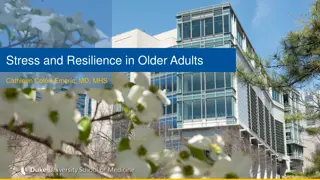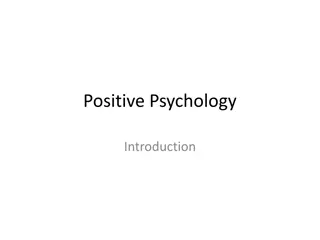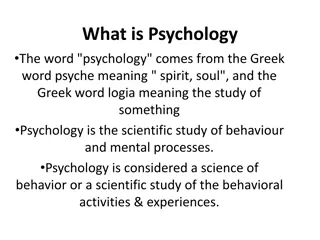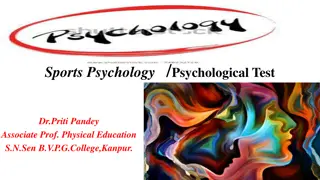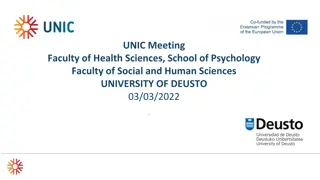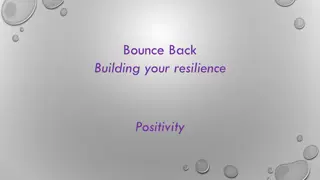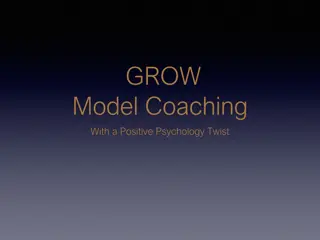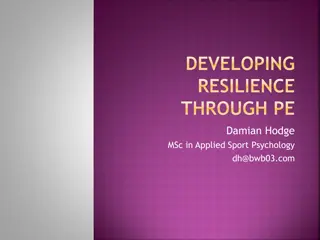Exploring Positive Psychology: Strategies for Resilience and Well-Being
Delve into the realm of Positive Psychology with applications for building resilience, promoting well-being, and cultivating a flourishing life. Discover ways to incorporate success, challenge, self-esteem, happiness, enthusiasm, luck, savoring, and more into your daily life. Explore concepts like mindset, self-compassion, mindfulness, post-traumatic growth, flourishing, and savoring to enhance your overall quality of life. Learn about the background of psychotherapy and different conceptualizations of human functioning throughout history.
Download Presentation

Please find below an Image/Link to download the presentation.
The content on the website is provided AS IS for your information and personal use only. It may not be sold, licensed, or shared on other websites without obtaining consent from the author. Download presentation by click this link. If you encounter any issues during the download, it is possible that the publisher has removed the file from their server.
E N D
Presentation Transcript
POSITIVE PSYCHOLOGY POSITIVE PSYCHOLOGY Applications for Resiliency and Well Applications for Resiliency and Well- -being (Cultivating and Sustaining a Good Life) being RECIPES FOR FLOURISHING AND SAVORING Michael Strangstalien, Clinician, Practitioner, Translational Researcher Counseling and Psychological Services The University of Arizona mstrangs@email.arizona.edu
The Quiz is in the Beginning How do you incorporate SUCCESS and CHALLENGE into your life? What are your ideas about SELF ESTEEM? What does it mean to be HAPPY? How do you proceed to a position of FLOURISHING, following tragedy, betrayal or setback? How do you exercise your ENTHUSIASM? What do you think about LUCK ? How do you practice SAVORING?
TAKE A MOMENT Be thinking about ONE element you can take away and apply directly to your life right now. If something pops up that is not clear, make a note and we will come back to that. If there is something you disagree with speak up, we will try to attend to the discussion, being mindful that we have a time constraint, so we may hold that discussion at the end.
Vocabulary Test MINDSET how you get ready for the big game FIXED MINDSET we are what we are GROWTH OR DYNAMIC MIND SET we can change who we are SELF-COMPASSION are you a heckler of yourself or a good defense attorney? MINDFULNESS deliberate, focus in a non-judgmental (non-reactive) manner in the present PTG Post-Traumatic growth HAPPINESS SETPOINT the baseline one tends to return to after highs and lows FLOURISHING (the opposite is languishing and psychopathology) optimal human functioning 4 parts goodness (contentment and effective performance), generativity (improving the lives of others), growth of personal and social assets, resiliency (growth following setback) SAVORING exercising enthusiasm, the act of enjoying everyday experiences FLOW that almost ecstatic place where you are in the zone
The Background FOUR WAVES OF PSYCHOTHERAPY AND CONCEPTUALIZATION OF HUMAN FUNCTIONING Analytic-dynamic Sigmund Freud, for example Behavioral BF Skinner, for example Humanistic Carl Rogers, for example Positivistic this is where we are today
How did we get here? Traditional mental health training historically focused on functional deficits, pathology and illness. Responding to the medicalized pathology model, the movement of Positive Psychology intended to focus on resourcefulness, resiliency, human strengths, happiness and how people prosper in the face of adversities and challenges. We will chart a brief history and survey some of the principle figureheads in this movement. The words self-esteem , "positive , "happiness and luck have some often misunderstood explanations and we will clear those up.
Abraham Maslow, Brandeis and Esalen Mid 1950s wrote a concluding chapter titled Positive Psychology in his book Personality and Motivation We are all familiar with his Hierarchy of Needs and the term Self- Actualization The Hierarchy of Needs (HON) Self Actualization: Eleanor Roosevelt, a Bronx Cab Driver He was actually more interested in the psychological attributes of the self-actualized person (less than 5% make it to this level!)
Some Useful Considerations about the HON The higher up the scale you move, the higher the incidence of anxiety The higher up the scale you move, the higher the incidence of depression The higher up the scale you move, the higher the incidence of loneliness The higher up the scale you go towards actualization, the more prone you will be to setbacks WOW!! This kind of sucks actually, the goal is to continually work towards flourishing and resiliency and bouncing back from setbacks So, we all encounter situations that are depressing or anxiety-provoking and they may not rise to the level of clinical depression or clinical anxiety and the goal of resiliency is to find a way out of being stuck To advance, you must secure the lower platforms to advance upward Throughout life, challenges will occur to the lower platforms, so work to quickly reinforce them
PSYCHOLOGICAL ATTRIBUTES OF SELF-ACTUALIZED PERSONS EFFICIENT PERCEPTION OF REALITY: separates fact from opinion, knows the difference from what is and what should/could be, knows that uncertainty can be a good teacher and willing to learn and be persuaded to change, not rigid RUGGED SELF-ACCEPTANCE: non judgmental of self and others, cares boldly for own health, acknowledges personal strengths, tolerates lack of perfection in others, takes responsibility for own actions NATURALNESS: able to be spontaneous, curious and simple (don t make things too complicated), almost childlike in life, aware of emotional-psychological world, enjoys simple pleasures of life, interested in own continual personal growth; able to be authentic and genuine GOAL ORIENTATION: the ability to focus oneself and attend to oneself and to others, not self-centered and demeaning of others, volunteers for others, takes sufficient care of self that there is energy to help others RESPECT SELF PRIVACY: comfort being with oneself and able to rely on one s judgments and decisions, able to accept this need in others
Continued AUTONOMY: independent of social validation and material goods, are you you or are you your things? , keeps inner peace even in hard times, not a slave to material comforts INTIMACY: ability to have openness and trust with at least one other person WONDER: discovers newness and novelty in old familiar things, finds beauty and good in most things, has a sense of awe with life rather than boredom, focuses more on positives rather than negatives CAPACITY FOR PEAK EXPERIENCE: willingness to experience good times, ability to celebrate small successes each day; the ability to say attaboy or attagirl to one s self and to others INDIVIDUALITY: independent of social restrictions and cultural distortions/norms, has a fresh regard for each new situation
CONTINUED CREATIVITY: a confident sense of freedom in everyday life activities, not a slave to conventional practice, eager to try new things and learn new things, generally keeps an open mind HUMOR: being able to be playful, not taking oneself too seriously, not demeaning or sarcastic; people describe you as fun to be around ETHICS: having confidence and guidance in one s sense of right and wrong DEMOCRATIC CHARACTER STRUCTURE: tolerant of the differences in others, accepting of others and forgiving in nature and spirit
The problem with POSITIVE The problem with HAPPY The problem with LUCK The problem with SELF ESTEEM Not so much about being positive, but more about being affirming to one s self when times get tragic, I say this is awful AND I will keep going Not so much about being happy as being comfortable with the wide range of emotions, events and thoughts that LIFE will deal out The Law of Allen Iverson luck only happens if you score while holding the ball as the clock expires Self Esteem (see Kristin Neff s 3 minute video on her website self- compassion.org - about self esteem versus self-compassion)
The Problem with Self-Esteem SELF-ESTEEM is a foggy concept, basically, we all have lousy self- esteem, some just practice it better since it is so foggy, we have to find another concept that can strengthen psychological resiliency and some practitioners latched on to the idea of FEELING GOOD, which I wholeheartedly endorse, except sh** happens and I can t feel good all of the time, so the antidote here is more to be able to be comfortable and content with everything that life throws my way more importantly, feeling good comes from DOING GOOD, except doing good doesn t always feel good SO, DOING GOOD implies accomplishing the day-to-day actions that lead to my DESIRED LIFE, THEN I feel good, THEN I walk around with the authentic, genuine swag of self-assuredness
Cut!!! Let s Review for a Minute
Mihaly Csiktszentmihalyi, Claremont McKenna, formerly at U. Chicago Autotelism (internal motivation and drive, pursuit for its own sake): Mental state balancing challenge level and skill level, according to Csikszentmihalyi's concept of FLOW
Nine Characteristics of FLOW Clear goals for each step Immediate feedback to guide action and improvement A balance between challenge and skill or ability Action and awareness merge and attention focuses on the present action Distractions are excluded from consciousness Failure is not anxiety-provoking or worrisome and almost greeted for its priming effects on improving Self-consciousness is minimal Sense of time becomes distorted The activity becomes autotelic (pursued for its own sake)
Martin E.P. Seligman, U.Penn. Collaborating with Cikszentmihalyi in the 90 s into the 2000s During the 1999 APA presidential address says he coined the term Positive Psychology Some of his contributions: 1. PERMA 2. Post Traumatic Growth 3. The 3 Appreciations (I call it Get Ready Get SET Go! ) 4. The Values in Action Inventory of Strengths - VIA (available on the internet)
PERMA Seligmans five elements of a meaningful life Positive Emotions see Frederickson s list Engagement involvement in activities that further fuels interests and culminates in achieving FLOW exercising enthusiasm Relationships interactions fuel positive emotions (as long as you have healthy people in your life) Meaning finding and fostering purpose and meaning Accomplishments pursuit of mastery and success
Post-Traumatic Stress (PTSD), versus Post- Traumatic Growth (PTG) When stuff (sh**) happens we all go boo hoo , oh, poor me , why me or WTF and it is alright to sit on our pity party for a little while I just don t want to get stuck there on that seat, ruminating about the past for too long (if I am not over something enough to be moving on, then maybe I should seek some professional consultation) . Because, if I don t get going if I am stuck in the past, that is the formula for becoming bitter, very mistrusting and resentful Do you know any people like this? They are usually stuck in the past for years
The ANTIDOTE to being Stuck The antidote to NOT being stuck is to find some sense of meaning (ie): Do I believe I will be able to build a meaningful life for myself? Do I believe I deserve a meaningful life? Do I believe I have the ability to accomplish what I need to do? What is one thing, no matter how small, that I learned from the event, and apply it forward to the future? What is one thing I can learn from this, no matter how insignificant, and then what is the one thing I will do differently next time? What did I learn about myself going through all of this?
Get Ready, Get SET SET, Go! The three appreciations: Name 3 things I am SATISFIED with Name 3 things I am ENTHUSIASTIC about Name 3 things I am THANKFUL for (As a variation, you may find it useful to name just one item for each of S E T) You will be surprised that when you apply this to something you are dreading, your mindset becomes more creative, productive and engaged.
When we face a challenge or adversity, Ethan Cross, University of Michigan, has discovered something THE USE OF I AND ALARMIST PREDICTION: I can t do this activates avoidance and anxiety and as a result, focus, concentration, motivation and memory are impaired (by as much as 40%!!!) MINDSET IS NARROWED THE USE OF YOUR NAME AND DO IT : by using the name in third person you achieve a bit of emotional separation, sort of like your coach is standing in back of you saying, come on Mike you can do this and as a result, motivation, concentration, memory and focus are increased and accelerated MINDSET IS BROADENED we will be talking more about this
The Values In Action Inventory of Strengths Seligman (Penn) and Christopher Peterson (U Michigan), 2004 6 Core Virtues selected from psychology and philosophy. (You may take the 240-item test and identify your core strengths and how to improve them by going to Valuesinaction) 1. Courage 2. Justice 3. Humanity 4. Temperance 5. Transcendence 6. Wisdom
VALUES IN ACTION INVENTORY OF STRENGTHS CREATIVITY I always like to do things in different ways I am not good at coming up with new ideas CURIOSITY I always want to know more I get bored easily OPEN-MINDED I am always able to look at the many sides of an issue Without much thinking, I usually accept what other people say or suggest LOVE TO LEARN When I want to learn something, I try to learn everything about it I learn new things only when someone makes me IMAGINATIVE I often come up with solutions to problems that make everybody happy I am not good at finding new solutions to problems BRAVERY I have the courage to do the right thing even when it is not popular I don t stand up for myself or others
VIA continued PERSISTENT When I start something, I always finish it Once I fail at something, I don t try it again HONORABLE INTEGRITY I keep my word and others can count on my word I lie to get myself out of trouble VITALITY OF SPIRIT Whatever I do, I throw myself into it I feel tired a lot and don t want to do anything COMPANIONSHIP When I have a problem, I know I have someone to talk with I don t need a best friend or adult to talk things through with KINDNESS OF HEART If there are new people around, I try to make them feel welcome I don t help others unless they help me first or if they don t ask, I won t volunteer to help SOCIAL INTELLIGENCE I always seem to know what to say to make people feel good I often seem to upset people without meaning to
VIA continued GROUP ALLEGIANCE OR LOYALTY I am very loyal to my group no matter what I don t agree with the group decision, I don t go along with it FAIRNESS When I work in a group, I give equal chance to everybody I do favors for those I know, even if it isn t fair to others LEADERSHIP When I play with others, they want me to be the leader When people in my group do not agree, I can t get them to work together FORGIVENESS AND MERCY When people say they are sorry I give them a second chance I apologize when I make a mistake or hurt someone s feelings Even if someone says they are sorry, I will stay mad at them HUMILITY AND MODESTY Rather than talking about myself, I prefer to let other kids talk about themselves I think that I am smarter than almost everyone else AVOIDS THE IDIOT FACTOR I avoid people or situations that might get me into trouble I often make mistakes because I am not careful and don t think things through
VIA continued SELF REGULATION OF ACTIONS Once I make a schedule or plan I stick to it If I have money, I usually spend it all APPRECIATION OF BEAUTY AND EXCELLENCE Seeing pretty pictures or things or hearing pleasing music makes me feel better I am not interested in art, opera, plays, dramas, music or dance GRATITUDE AND THANKFULNESS I often feel lucky to have the parents, family and friends that I have I am not good at expressing my gratitude HOPE I can find something good in any situation, even when others cannot I give up when things do not go well HUMOR AND FUN TO BE WITH I am good at making people laugh I don t have a good sense of humor SPRITIUALITY AND PURPOSE IN LIFE When I am upset, I often pray I don t believe in any God
Angela Duckworth, U. Penn 2013 MacArthur Fellow Collaborates with Seligman Applications to secondary school GRIT 4 skills 1. Trust my gut, have a goal, have an aspiration 2. Do the work to achieve the goal, create opportunity 3. Expect success, walk around with genuine, authentic swag 4. Spin the bad news if something goes wrong
Barbara Frederickson, UNC-Chapel Hill Broaden and Build: The broaden-and-build theory describes the form and function of a subset of positive emotions, including joy, interest, contentment and love. A key proposition is that these positive emotions broaden an individual's thought-action repertoire: JOY sparks the urge to play, INTEREST sparks the urge to explore, CONTENTMENT sparks the urge to savor and integrate, and LOVE sparks a recurring cycle of each of these urges within safe, close relationships. The broadened mindsets arising from these positive emotions are contrasted to the narrowed mindsets sparked by many negative emotions (i.e. specific action tendencies, such as fight, flight, fright or freeze).
Expanded (Broadened) Mind Set A second key proposition concerns the consequences of these broadened mindsets: by broadening an individual's momentary thought-action repertoire--whether through play, exploration or similar activities--positive emotions promote discovery of novel and creative actions, ideas and social bonds, which in turn build that individual's personal resources; ranging from physical and intellectual resources, to social and psychological resources.
Narrowed Mindset Fight: impatient, irritable, overly argumentative, confrontational Flight: give up, quit, escapist Fright: experiential avoidance, alarmed, overwhelmed easily, tendency to terrorize your own mind Freeze: immobilized, psychologically paralyzed, unable to make a decision, rigid outlook, alienate people
Barbara Frederickson, UNC-Chapel Hill The TEN emotional states they have identified as expanding mind-set repertoire are: JOY simple excitement, similar to what our dog does when you pick up the leash GRATITUDE acknowledging people who are important in our life SERENITY contentment, at ease, comfort with circumstances, acceptance INTEREST exploration, challenge when not overwhelming HOPE expecting and working for a good outcome (especially in dire circumstances) PRIDE takes appropriate credit for a good outcome and creates the spark to pursue even bigger accomplishments, (achievement motivation) AMUSEMENT simple fun builds and reinforces social bonds INSPIRATION in the presence of human excellence, ignites aspiration AWE in the presence of someone or something great, magnanimous or powerful or knowledgeable and aspiration is furthered LOVE the appreciation of simplicity, beauty and interpersonal connection
Carol Dweck, Stanford Mind Set Perseverance, Persistence and Hard Work pay off more than SMARTS Think about this relative to the discussion on Self Esteem, that is, DOING GOOD, which leads to feeling good, which leads to quiet confidence and self-assuredness In other words, doing the things that lead to my desired life Currently studying motivation and competence
CUT!!! Let s review for a minute
OCEAN: The Five Factor Model of Psychological Functioning and Resiliency Emerged in early 60 s and formalized by Raymond Cattell of the U of Ill. in the 80 s and Paul Costa and Robert McRae of NIH in late 80 s early 90 s (many have probably read Costa and McRae s text on personality) and serves as a foundation for the domain of personality disorder diagnosis and major mood disorders in DSM-5 In the domain of Positive Psychology five factors are considered necessary and sufficient to contribute to psychological well-being That is, my ability to bounce back from adversity and recover from stress The goal here is to not be too much of the characteristic and not be too little In other words, seek a moderating level And if you bring one factor closer to moderation, all five seem to gravitate towards moderation
O O: I tend to be open to new ideas and emotions and behaviors versus overly rigid and inflexible; I tend to be rather tolerant of others and eager to learn I tend to be optimistic versus being a negaholic or being a bitter person or only being able to access the predominant emotion of angry or mad or pissed off these people tend to be poorly psychologically available (I can access emotions of hurt, fear and frustration instead of just anger)
C C: I am conscious, not too self-conscious and not oblivious to my impact on others; (EQ emotional intelligence) I can read my emotions and thoughts; I can read the emotions and thoughts of others; I can manage my thoughts and emotions; I can manage the thoughts and emotions of others because I can be deliberate and disciplined, I tend to be achievement motivated
E I externalize I tend to not take anything too personally (and at the other extreme I am not a complete sociopath) I can practice my extraverted self and be warm, assertive and activity-oriented E: I externalize, when facing tough stuff, I can get immobilized a little, then I surge on, I get out of my head and DO versus giving up
A A: I am assertive and agreeable I speak up and I can be civil about it; I am conscious of how my words and thoughts and ideas are received by someone else I am generally regarded as trustworthy and as a trusting person in general, I tend to be modest and also willing to toot my own horn when necessary because I am straightforward
N N: I am free of neurotic tendency (neurotic is being over-reactive, histrionic, overly dramatic, freak out over the littlest things, over expression of emotion) I tend to have a high set point so that when anxiety provoking things get me riled, I can settle back down and when depressing things get me down, I tend to rise up again I can be easy going and yet deliberate and intentional
Big Five Self Rating Openness to New Experiences ________________________________________ 1 2 3 4 ________________________________________ 1 2 3 4 ________________________________________ 1 2 3 4 ________________________________________ 1 2 3 4 ________________________________________ 1 2 3 4 ________________________________________ 1 2 3 4 ________________________________________ 1 2 3 4 5 6 7 Optimistic 5 6 7 Conscious 5 6 7 External- take nothing personally 5 6 7 External-surgent 5 6 7 Assertive and agreeable 5 6 7 Not Neurotic 5 6 7
Self Assessment of the Big Five 1 denotes extreme absence of the temperamental style 2 denotes relative absence of the temperamental style 3, 4, and 5 denote a moderating influence (the ideal) 6 denotes relative predominance of the style 7 denotes extreme predominance of the style REMEMBER: These factors are recursively inter-related, such that if I bring one aberrant factor to the moderate level, all factors drift towards moderation
Ed Diener University of Illinois, retired, now senior researcher at Gallup Poll While at Illinois, was the Smiley Endowed Chair in Psychology and often referred to as Dr. Happiness The Satisfaction With Life Scale has been used in a variety of settings and seems to hold up to reliability and validity scrutiny
SWLS scoring 7 - Strongly agree 6 - Agree 5 - Slightly agree 4 - Neither agree nor disagree 3 - Slightly disagree 2 - Disagree 1 - Strongly disagree
SWLS ____ In most ways my life is close to my ideal. ____ The conditions of my life are excellent. ____ I am satisfied with my life. ____ So far I have gotten the important things I want in life. ____ If I could live my life over, I would change almost nothing.
SWLS Interpretation 31 - 35 Extremely satisfied 26 - 30 Satisfied 21 - 25 Slightly satisfied 20 Neutral 15 - 19 Slightly dissatisfied 10 - 14 Dissatisfied 5 - 9 Extremely dissatisfied
Emerging Trends and Applications Values in Action (VIA) Survey Radical Acceptance and Mindfulness (Tara Brach, Jon Kabat-Zinn) Compassion and Empathy Training Ed Diener s Satisfaction With Life Scale (SWLS) James Pennebaker and Expressive Writing Therapy Self Compassion of Kristin Neff Richard Davidson and Jon Kabat-Zinn on the Neuroscience of Mindfulness In general, life coaching and executive coaching Applications for enhancing romantic relationships Applications in business to improve employee relations Applications in the classroom Behavioral Economics (Daniel Kahneman, Princeton, Nobel Laureate 2002) I would include Daniel Siegel s work on Interpersonal Neurobiology (IPNB) I would also include Stephen Hayes work on Acceptance and Commitment Therapy
Take a Moment What is one thing you can take away today and apply directly to your life? What is one thing that is not clear? What is one idea that you disagree with?



